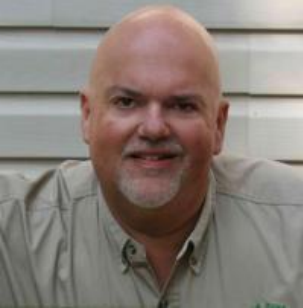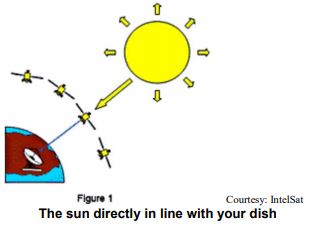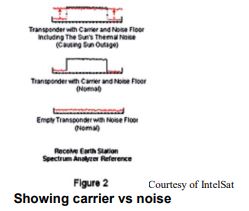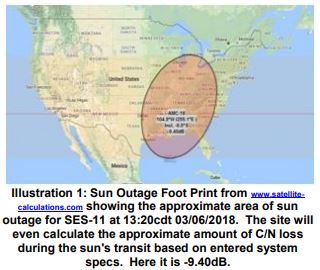Here It Comes Again… Sun Outage Time

[February 2018] Sun Outage times this Spring will be different than usual. Kevin Kidd explains why, and what you need to know.
Twice a year since the beginning of time (or at least satellite delivered programming time), we have been dealing with loss of satellite signals (LOS) due to the phenomenon called Sun Outage, Sun Transit or Sun Fade.
The outage occurs when the Sun lines up almost perfectly behind the desired satellite as viewed from the earth station.

This perfect alignment occurs within a few days of both the spring and fall equinox.
When your PD complains about having to manually cover the outage, the simplest answer is to just tell them that your dish is pointed at a tiny little satellite orbiting out at 22,300 miles and that big old, mean sun is going to photo bomb the bird from 92.5 million miles further out in space.
Knowing But Forgetting
No, there is not any way to schedule it at some other time.
Each year, many of my customers feel compelled to call and ask if the reason that their receivers all crashed at the same time was due to the “sun spots” – even though they had received alerts from myself and a dozen different network suppliers giving specific days and hours for coming Sun Outages.
Here is what is going on.
Big Noise Maker
In fact, the Sun is a gigantic noise generator that produces about 386 yotta-Watts (that is with 24 zeros) of thermal and noise energy that will easily overwhelm the relatively weak 20 Watts/ transponder of even the new SES-11 (the replacement for AMC18).

If you are using a large well-aimed dish that is in good condition, your actual LOS (Loss Of Signal) may only be a minute or two at the worst for only a couple of days. On the other hand, if you have low EB’s and AG’s due to a marginally sized dish, a dish that is not properly aligned or is damaged, you may lose several minutes per day for several days.
Of course, if you are running one of those satellite networks that provides an Internet backup stream directly to their receivers, you may not even know that there is anything going on. The backup stream will cover and fully duplicate the satellite programming while the signal is wiped out.
Different networks will have somewhat different outage times due to their relative downlink power levels.
Receivers/dishes aimed at different satellites from the exact same earth station location will all suffer LOS on the same basic range of days but at different times of the day.
A Better Location
One improvement of the transition of most commercial radio programming from AMC-8 to AMC-18/SES-11 is that the sun outage LOS occurs earlier in the day and outside of drive times for most areas of the country.
Depending on the location and dish situation, there will be some level of degradation possibly starting on or about February 25th in the far northern continental US and continuing through about March 12th in the far southern tip of Florida. That is not to say that the degradation will be bad enough to overload the receivers but that in certain dish and signal situations, it could happen.
More than likely, during the outage period, you will have a couple days of increasing blips and burps for a few minutes, followed by a couple of days of total outage for a few minutes, followed by a couple more days of decreasing blips and burps for a few minutes.
If your satellite service goes down for 15 or more minutes or outside the published outage times for your location, Sun Outage probably is not the cause.
Identifying Sun Outages
There are a number of sun outage calculators on the web where you can predict dates and times, but a couple of my favorites are:
http://www.cromack.com/satsun.html which is fully configurable and https://www.satellitecalculations.com/Satellite/suninterference.php which is even more configurable.
The http://www.satellite-calculations.com site also has a cool sun outage visualization generator that will produce a graphic time lapse visualization of the path and extent of the minute-by-minute outage path.

Beware that by default, the map is usually initially zoomed in to a point that makes it appear to be just a solid colored box. You can zoom out several times to see a usable map.
When Sun Outage is Good
How, you might ask, can a sun outage possibly be a good thing.
Let us suppose that you are planning a new dish installation like I was back in the fall of 2014. The new studio location was in a wonderful old house surrounded by 70-foot tall pine, poplar and oak trees.
We talked to a local surveyor who said that he would have to take a sun shot and then calculate where the satellite would be in reference to that, then skew the transit around to the calculated position, etc, etc. And if we guessed wrong on the initial location, do it again and again until we centered one of the available clearings.
Did we have a path to the satellite (AMC-8 at that time)? I was absolutely certain that we had several potential paths but could not say exactly where we should plant the new 3.7 m Prodlin dish to look between the trees. The dish was going to be mounted on a non-penetrating mount but we really did not want to have to load and unload over 100 concrete blocks more than once.
An Easy Way to Point
I have a really cool smart phone enhanced reality app called DishPointer that is wonderful for surveying and aiming dishes but it does depend on the accuracy of the phones internal compass and sensors.
Unfortunately, at this site, a HV power line runs across the edge of the property that was totally out of play for the dish but drove the compass in my phone absolutely nuts to the point of making it useless. It also caused my old military compass to wildly skew around dozens of degrees as if we were shooting a doomsday movie.
But, wait! How about a sun shot in early October when sun outage advisories were flying around like confetti. I ran back to the new studio location on one of the predicted sun outage days and took a quick walk around the parking lot as soon as I heard the satellite burp and go silent.
During the five minute outage, I marked several locations that had good views of the sun thru breaks in the trees and later came back to the site with the owner to pick one. When we installled the new dish, it was dead centered in the chosen break in the trees.
Without the seasonal sun outage, the owner might have had to pay a surveyor several hundred dollars to do several sun shots at potential dish locations or me to assemble and move the dish several times.
Please note that unless your clearing is extremely narrow, you can extrapolate the satellite’s position from the sun’s location for several days before or after the sun outage maximum if you cannot check it dead center in the max.
It Worked!
After the renovations proceeded through the winter, we built the studio and installed the new dish in the Spring of the next year just before the Spring Equinox.
We assembled and mounted the big Prodlin dish and then we intentionally waited until the next day’s calculated sun outage maximum. We spun the dish around and tilted it up until the shadow of the feed was centered in the Prodlin center hub and locked it down temporary.
Later, after installing the LNB I found what would have been enough signal to have locked most receivers without touching the AZ/EL adjustments. It was not perfect by any means but was closer than I sometimes come using careful measurements, A quick effort maximized the received signal, and this one is ready to serve for years.
Meanwhile, we encourage you to be working on your witty responses to the PD that you had just reminded for the 5th time.
– – –
Kevin Kidd, CSRE/AMD, is the proprietor of AM Ground Systems Company and KK Broadcast Engineering.
You can contact Kevin at: kkidd@kkbc.com or via: www.amgroundsystems.com
